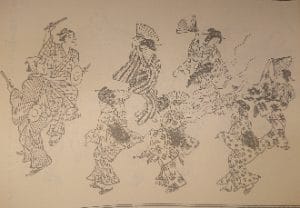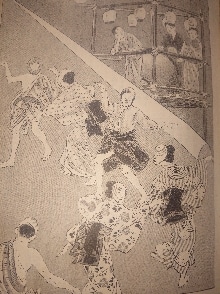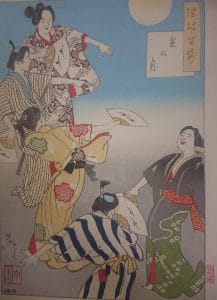Overview
From Edo to Meiji
After the Meiji Restoration, the policy of westernization led to an era in which old customs were seen as evil and moved to be eliminated. In the midst of rapid “modernization,” Bon Odori was greatly affected and transformed. Originally, Bon dances were prohibited in large cities (Edo, Osaka, etc.), but local Bon dances were also banned on the grounds that they disturbed public morals. The regulations were loosened a little, and then cracked down on again, but Bon dances remained stubbornly in place.
This period
.
From the upheaval at the end of the Edo period, a new government was established after the Boshin War. After the Seinan War, domestic battles came to an end, and the government moved forward to build a nation capable of competing with other countries. Not only political changes, but also industrial structure such as industry and commerce changed drastically. The country also experienced two major wars, the Sino-Japanese War and the Russo-Japanese War.
1868 Boshin War
1871: Abolition of feudal domains
1877 Seinan War
1870s and 1880s: Industrial and commercial development policy
1880s: Europeanization policy
1889: Constitution promulgated
1894 Sino-Japanese War
1904 Russo-Japanese War
1909: Domestic disc record released
Basic Information
Population: Around 40 million and growing rapidly
Attribute type: Equality among the four classes.
Longevity: About 45 years old
Famine and disaster conditions: Bad harvest every few years (especially in Tohoku Region), earthquakes, tsunamis, typhoon damage, heavy snowfall, Spanish flu, etc.
Media of transmission: Written media became the main media due to the expansion of school education
Territorial system: Individuals, landowners holding land
Common people’s clothing: Kimonos (traditional Japanese clothing) predominant, but Western clothing gradually increased
Food for the common people: Barley rice is the staple food, vegetables, seafood, and meat consumption is lifted its ban.
Housing for the common people: Japanese wooden houses, large families
Entertainment opportunities for the common people: Bon dances were banned not only in cities but also in villages, but they persisted as a meeting place and entertainment for men and women. With westernization, leisure diversifies step by step.
Religion
.
Shinto and Buddhism Separation Order 1868, issued in the first year of Meiji
The Meiji government purified Shinto and made it one of the pillars of national policy. To this end, it issued an order separating Shinto and Buddhism.
This led to the movement to abolish Buddhism, starting with Mount Hiei, which destroyed temples and Buddhist statues. This movement was not the intention of the government, but it escalated. Some say that the number of the temples decreased to half of its original number of 90 thousand. The movement was particularly violent in areas such as southern Kyushu.
The separation of Shinto and Buddhism also suppressed folk beliefs. During the Edo period, Buddhism and Shintoism were mixed in the same places, and folk beliefs were a mixture of Buddhism, Shintoism, Taoism, and original local beliefs and nature worship. This changed drastically during the Meiji period. Folk beliefs and the mixture of Shintoism and Buddhism continued to be strong in some parts, but the idea of the separation of Shinto and Buddhism had considerable influence, and this trend spilled over into Obon events and Bon dances.
Reference: The Meiji Restoration of the Gods: Yoshio Yasumaru
Buddhism obliterated: Hidenori Ukai
Bon Odori: What happened around this time
“Prohibition” of Bon Dancing
Around 1874, bans were issued in many places.
| Literary name | era name | AD | Content | ||||||||||||||||||
|---|---|---|---|---|---|---|---|---|---|---|---|---|---|---|---|---|---|---|---|---|---|
| Notice of Bon Dancing Prohibition (Gifu Prefecture) | Meiji7 | 1873 | Prohibition of Bon Dancing | ||||||||||||||||||
| Notice of Bon Dancing Prohibition (Nara Prefecture) | Meiji7 | 1873 | Prohibition of Bon Dancing | ||||||||||||||||||
| Notice of Bon Dancing Prohibition (AichiPrefecture) | Meiji10 | 1876 | Recommendation to refrain from Bon Dancing | ||||||||||||||||||
| Notice of Bon Dancing Prohibition (Ehime Prefecture) | Meiji14 | 1880 | Prohibition of Bon Dancing |
Changes in Bon Dancing, “modernization” of Bon Dancing (for reasons of public morals)
Loosening of Bon dance regulationsIn the mid-Meiji period, regulations on Bon Dancing began to loosen.
Nippon no Jiji, September 1, 1888, No. 7
.
It depicts Bon Dancing, which had been cracked down on by the police, being silently approved and becoming lively again. It also shows how Bon Odori was a place for interaction between men and women.
Article Summary (Intended Translation)
Hundreds of men and women, young and old, gather together, without distinction of rank, and hoist lanterns, their voices echoing, their dancing booming, and their hands clapping. This is the Bon dance in the countryside. It is held on the streets of the city, in front of the gates of local feudal lords, and in the woods of local Shinto shrines, on the night of July 15 or 16, the Bon festival season. Men dress up in women’s clothes, women in men’s clothes, some in rags, and men in aristocratic attire, all dressed in bizarre and unexpected ways, competing to catch everyone’s attention. The dances are indecent and lewd, and the emotions of men and women intermingle, sometimes resulting in a one-night stand and even the birth of a child. Thus it corrupts public morals, and there was a crack down. This Bon Odori dance was common in the countryside, but it was especially popular in the Tohoku region.
I traveled to Tohoku for a summer vacation, which fell on August 15-16. In Tōhoku, many people celebrate this season as Ura-Bon, neither on the yang calendar nor on the yin calendar, but in a way in between. This year, western Japan was hit hard by flooding and other disasters, but the weather was very good in the Tohoku region, and crops bore well. Farmers were in high spirits, which spread to the people in the commercial and industrial fields, and they beat their bellies and chests in a lively Bon Odori dance of yesteryears. Men and women, young and old, were dancing and making noise in a frenzy. Even the police tolerated this. Some might raise an eyebrow at this. “Oh, the public morals are being disrupted again. However, I think that the author is right. I think that balls are held in glittering venues, with men and women embracing and prancing around. What is the difference between a masquerade ball and a Bon Odori costume? If customs are to be corrected, shouldn’t it be done from the top, not from the common people?
There are still many people who say that everything is better in the West, that playing cards is good while playing karuta is bad, that Bon dances are bad while balls are good, that loyalty is lower than treason, and so on. Even if we strictly forbid the public morals of the common people, it will not help if we don’t correct the source of the problem. Because of this, the police have recently become chic and have begun to tolerate Bon dances.
In ancient times, the Chinese learned of the plight of farmers from the signs of climate change, but the farmers are rejoicing in this way because the weather is favorable and a good harvest is expected, so they should rather enjoy themselves greatly. Bon dances and village theatrical performances are both good. Fuzoku Gahou, August 10, 1891
(Japanese Folklore Magazine)
The following Bon dances are introduced. In particular, the Bon Odori in Tsuruoka is no less than the festival of Kanda Myojin, and people from all over the area are described.
The following Bon dances are described.
Bon Dancing in Uzen Tsuruoka (present-day Tsuruoka City, Yamagata Prefecture), Bon Dancing in Kii Arita County (around Kii Arita Station, Kushimoto City, Wakayama Prefecture), Kanko Dancing in Ichinose Village in Echizen Fukui (Ichinose, Fukui City)

From “Fuzoku Gaho” (genre picture report) from the Meiji 24 (1894). Collection of the Shonan Bon Dance Study Group
Fuzoku-gaho, July 10, 1897
.
The following Bon dances are introduced. You can see that all of them are bustling with people.
Kawachi Ondo, Bon Dancing in Tsuruoka (same as the previous section), and Bon Dancing in Shinano Higashi-Chikuma-gun Nihmura (present-day Nihmura, Matsumoto City) are introduced.

Illustration of Kawachi Ondo from the Fuzoku Gaho from 1897 (Collection of the Shonan Bon Dance Study Group. )
Bon dance depicted
This is a Bon dance picture painted by Ukiyoe artist Yoshitoshi Tsukioka from the late Edo period to the early Meiji period, depicting a hundred figures of the moon, the month of Bon, and Edo as he envisioned it.

Tsuki-no-hyakushi, Bon Festival Moon by Yoshitoshi Tsukioka, image is a reprint (owned by the Shonan Bon Dance Study Group)
Decline of Bon Dancing due to Policy
Eitaro Komatsubara, Minister of Education in the second Katsura Cabinet from 1908 to 1911, and Tosuke Hirata, Minister of Home Affairs, initiated a ban on Bon Dancing and began to purge farming villages. He went around preaching the abolition of Bon Dancing as the main culprit of production disruption and public morals disorder. He called it “Bon Dance Extermination. This had a great impact, and when I visited farming villages and asked, ‘When did they stop Bon dances here?’ Many old people replied, ‘Around the end of the Meiji period or the beginning of the Taisho period.
Relationship with the Industrial Revolution
Even in the environment described above, the budding of a new Bon dance movement was seen, and the industry and traditional Bon dances overlapped.
The Industrial Revolution brought about the emergence of workers.
Companies and workplaces became new communities.
The emergence of industrial Bon dances (workplace communities, recreation)
“Tomioka Silk Mill and Bon Dancing”
On June 19, 1873, the Empress left the Imperial Palace in a carriage with Empress Dowager Eisho (Empress Dowager to Emperor Koumei), and on the 24th, they visited the Tomioka Silk Mill. The story of that visit is written in the Tomioka Diary.
<From Tomioka’s diary>
One day, one of the supervisors said to the workers, who were from Nagano Prefecture, “If you know that there is a Bon dance in your country, please dance it”. At first, everyone was reluctant to join the dance, but it became so popular that after 4 or 5 people danced, the number increased by one or two, and then by more and more, at last it became 20 to 30. When I also joined the dance, the bureaucrats including Mr. Odaka and Mr. Aoki became so delightful and tens of factory women watched the dance.
The industrial revolution gave birth to the “Tankobushi”
.
Coal dressing plant at the Mitsui Tagawa Ita Mine
Ita Machine Coal Selection Bushi: Compiled by Yoshika Ono → Became the original song of the Tankobushi
History of Bon Dance
- 0-1 The History of Uraabon
- 0-2 Ancient Japanese customs of the common people (not documented)
- 0-3 Late Heian Period, just before the birth of Bon Dancing
- 1.Kamakura Period Birth of Dancing Nembutsu
- 10.Heisei Reiwa: From Stagnation to the Birth of a New Axis
- 2.Birth of Bon no Furyu Odori (Bon Dance) in the mid-Muromachi Period
- 3.Late Muromachi – Sengoku – Azuchi-Momoyama Rise of Fuuryu Odori and Regional Expansion
- 4.Early Edo Period Establishment of Bon Dancing
- 5.Mid to Late Edo Period Bon Dancing takes root and matures
- 6.Meiji: A Turning Point for Bon Dancing
- 7.Taisho Era – Early Showa Era Revival of Bon Dancing
- 8.Before and After the War Wartime Response, Suspension and Resumption
- 9.Late mid-Showa period Nationwide expansion of Ondo and Minyo (folk songs)
